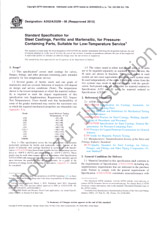Wir benötigen Ihre Einwilligung zur Verwendung der einzelnen Daten, damit Sie unter anderem Informationen zu Ihren Interessen einsehen können. Klicken Sie auf "OK", um Ihre Zustimmung zu erteilen.
ASTM E3310/E3310M-21
Standard Test Method for Evaluating Response Robot Mobility Across Parallel Rails
Name übersetzen
NORM herausgegeben am 15.11.2021
Informationen über die Norm:
Bezeichnung normen: ASTM E3310/E3310M-21
Anmerkung: UNGÜLTIG
Ausgabedatum normen: 15.11.2021
SKU: NS-1045510
Zahl der Seiten: 12
Gewicht ca.: 36 g (0.08 Pfund)
Land: Amerikanische technische Norm
Kategorie: Technische Normen ASTM
Die Annotation des Normtextes ASTM E3310/E3310M-21 :
Keywords:
capability testing, emergency responder, emergency response, maneuvering, operator proficiency, parallel rails, robot evaluation, robot mobility, robot test,, ICS Number Code 25.040.30 (Industrial robots. Manipulators)
Ergänzende Informationen
| Significance and Use |
|
5.1?This test method is part of an overall suite of related test methods that provide repeatable measures of robotic system mobility and remote operator proficiency. The parallel rails test challenges robotic system locomotion, operator control, effective camera positioning, chassis shape variability (if available), and remote situational awareness by the operator. As such, the parallel rails test can be used to represent situations where hazards must be avoided by the robot (for example, debris, puddles) surrounding a path in the environment, highlighting situational awareness demands on the operator while controlling the robot. 5.2?The scale of the apparatus can vary to provide different constraints representative of typical intended deployment environments. For example, the three configurations can be representative of repeatable complexity for unobstructed environments (open configuration), relatively open parking lots with spaces between cars (rectangular confinement configuration), or within bus, train, or plane aisles, or dwellings with hallways and doorways (square confinement configuration). 5.3?The test apparatuses are low cost and easy to fabricate so they can be widely replicated. The procedure is also simple to conduct. This eases comparisons across various testing locations and dates to determine best-in-class systems and operators. 5.4?EvaluationThis test method can be used in a controlled environment to measure baseline capabilities. The parallel rails apparatus can also be embedded into operational training scenarios to measure degradation due to uncontrolled variables in lighting, weather, radio communications, GPS accuracy, etc. 5.5?ProcurementThis test method can be used to identify inherent capability trade-offs in systems, make informed purchasing decisions, and verify performance during acceptance testing. This aligns requirement specifications and user expectations with existing capability limits. 5.6?TrainingThis test method can be used to focus operator training as a repeatable practice task or as an embedded task within training scenarios. The resulting measures of remote operator proficiency enable tracking of perishable skills over time, along with comparisons of performance across squads, regions, or national averages. 5.7?InnovationThis test method can be used to inspire technical innovation, demonstrate break-through capabilities, and measure the reliability of systems performing specific tasks within an overall mission sequence. Combining or sequencing multiple test methods can guide manufacturers toward implementing the combinations of capabilities necessary to perform essential mission tasks. |
| 1. Scope |
|
1.1?This test method is intended for remotely operated ground robots operating in complex, unstructured, and often hazardous environments. It specifies the apparatuses, procedures, and performance metrics necessary to measure the capability of a robot to maneuver across parallel rails. This test method is one of several related mobility tests that can be used to evaluate overall system capabilities. 1.2?The robotic system includes a remote operator in control of most functionality, so an onboard camera and remote operator display are typically required. This test method can be used to evaluate assistive or autonomous behaviors intended to improve the effectiveness or efficiency of remotely operated systems. 1.3?Different user communities can set their own thresholds of acceptable performance within this test method for various mission requirements. 1.4?Performing LocationThis test method may be performed anywhere the specified apparatuses and environmental conditions can be implemented. 1.5?UnitsThe International System of Units (a.k.a. SI Units) and U.S. Customary Units (a.k.a. Imperial Units) are used throughout this document. They are not mathematical conversions. Rather, they are approximate equivalents in each system of units to enable use of readily available materials in different countries. The differences between the stated dimensions in each system of units are insignificant for the purposes of comparing test method results, so each system of units is separately considered standard within this test method. 1.6?This standard does not purport to address all of the safety concerns, if any, associated with its use. It is the responsibility of the user of this standard to establish appropriate safety, health, and environmental practices and determine the applicability of regulatory limitations prior to use. 1.7?This international standard was developed in accordance with internationally recognized principles on standardization established in the Decision on Principles for the Development of International Standards, Guides and Recommendations issued by the World Trade Organization Technical Barriers to Trade (TBT) Committee. |
Empfehlungen:
Aktualisierung der technischen Normen
Wollen Sie sich sicher sein, dass Sie nur die gültigen technischen Normen verwenden?
Wir bieten Ihnen eine Lösung, die Ihnen eine Monatsübersicht über die Aktualität der von Ihnen angewandten Normen sicher stellt.
Brauchen Sie mehr Informationen? Sehen Sie sich diese Seite an.




 Cookies
Cookies
